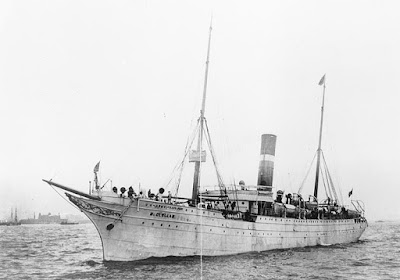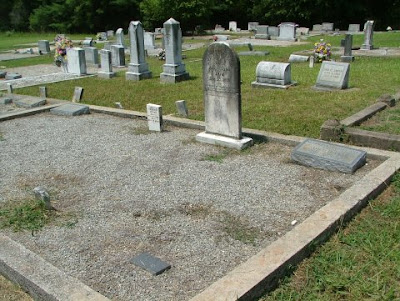Muzette Cheney, daughter of William “Henry” Cheney and Martha “Mattie” C. Callahan, was born on October 17, 1879, most likely in Bairdstown, Oglethorpe County, Georgia. She was the oldest child of 10—Muzette Cheney, Guy Pleo Cheney, Thomas R. Cheney, Lora Cheney, Sarah A. Cheney, Lucille Cheney, Pauline Cheney, Clara I. Cheney, Carl Brisco Cheney, and Henry J. Cheney. Muzette is my 2nd cousin of husband of 2nd cousin 3x removed. We have no common relative.
Muzette’s father Henry was a “widely popular citizen” in their community and a “veritable pillar” of Bairds Baptist Church in Bairdstown, which is where the census enumerator found the family living on June 5, 1880. Muzette was six months of age and the record noted that she was born in December. Her father was a farmer; her mother was keeping house. There were two servants living with the family in the home—a 17-year-old black female named Ida Brisco and a 47-year-old black female named Josie Craddock. They lived next door to Muzette’s maternal grandparents Thomas and Ann Jane (Briscoe) Callahan.
In August 1886, six-year-old Muzette performed at an exhibition held in the grove of the Bairdstown Academy. The exhibition took place on what was described as a pleasant evening and was attended by “ladies and gentlemen from Union Point, Crawford, Woodstock, Wilkes county, Gray Lands and other places.” It included a series of performances by the “popular Crawford band” and theatrical sketches of comedy and drama. An article published in the Georgia Home Journal on August 6, 1886 mentioned Muzette’s performance by name:
The “Sick Doll,” was a triologue, by little Miss Muzette Cheney, doll’s mother, and Miss Willie Wilson, doll’s friend, and Terry Wingfield, doctor. None of these were over seven years of age. The wee ones, in the delicate drapery of lawn set with nature’s own ornaments of bright flowers, their cheeks aglow with life and pleasure, their merry eyes sparkling with happy excitement, their locks—brown and golden—bewitchingly combed about their pure white brows, had to the reporter’s eyes the witchery of fairies.The 1890s were hard on the Cheney family with Muzette’s mother losing two infants—Clara, born March 1891 and died September 1891 and the youngest child of the family, Henry, born August 1895 and died December 1895. Little Henry was apparently sick for some time before his death. As the oldest child (and daughter), Muzette would have helped her mother with the smaller children so the deaths of these infants were probably hard on her. Both infants were buried at Bairdstown Cemetery there in Bairdstown.
In January 1900, Muzette left home and moved to Smithville, Lee County, Georgia, to take a job as a school teacher. Smithville, a part of Albany, Georgia, is 168 miles from Bairdstown and a long way from home. On June 12, 1900, she was enumerated in Smithville, living alone and working as a school teacher. In this census record, the enumerator noted that she was born in October, not December as in the 1880 census record.
Muzette contracted typhoid fever sometime in 1904. Sadly, she died from the disease at 6 o’clock in the morning on July 8. Her funeral was held the next day at 10 o’clock in the morning at Bairds Baptist Church in a service officiated by Rev. J. D. Mell. Muzette was only 24 years old when she was laid to rest in Bairdstown Cemetery.
There is a tall obelisk monument and a stone marking Muzette’s grave in the cemetery. Although hard to read in my photos, the photo uploaded to her Find-A-Grave memorial clearly shows the words on the monument. The obelisk monument reads:
There’s a beautiful region above the skiesAnd I long to reach its shore.For I know I shall find my treasuer [sic] thereThe loved one gone before.
The stone lays flat on the ground and contains her birth and death dates, along with the names of her parents. I don’t know if it is part of the obelisk monument that has come loose or if it was an actual upright stone at one point and has fallen over.
- Find a Grave, database and images (https://www.findagrave.com: accessed 29 May 2020), memorial page for Muzette Cheney (17 Oct 1879–8 Jul 1894), Find a Grave Memorial no. 42428307, citing Bairdstown Cemetery, Oglethorpe County, Georgia, US ; Maintained by Shelley Miller (contributor 47081838).
- McRee Jr., Fred W., “Oglethorpe County, Georgia Deaths, 1874–1938,” Oglethorpe Echo, pp. 77, 135 and 310–311, July 15, 1904.
- “Pleasant Evening: An Exhibition by Prof. Wingfield’s School Friday Evening,” Georgia Home Journal, Greensboro, Georgia, August 6, 1886.
- U.S. Federal Census, Bairdstown, Oglethorpe, Georgia, 1900.
- U.S. Federal Census, ED 21 Militia District 976 Smithville Town, Lee County, Georgia, 1900.
- U.S. Federal Census, Village of Bairdstown, District 232, Oglethorpe, Georgia, 1880.
- Union Recorder, Milledgeville, Georgia, January 9, 1900.


















